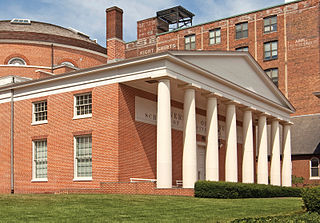
The University of Maryland, Baltimore (UMB) is a public university in Baltimore, Maryland. Founded in 1807, it comprises some of the oldest professional schools of dentistry, law, medicine, pharmacy, social work and nursing in the United States. It is the original campus of the University System of Maryland and has a strategic partnership with the University of Maryland, College Park. Located on 71 acres (0.29 km2) on the west side of downtown Baltimore, it is part of the University System of Maryland.
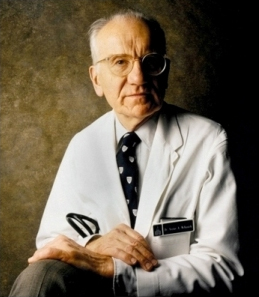
Victor Almon McKusick was an American internist and medical geneticist, and Professor of Medicine at the Johns Hopkins Hospital, Baltimore. He was a proponent of the mapping of the human genome due to its use for studying congenital diseases. He is well known for his studies of the Amish. He was the original author and, until his death, remained chief editor of Mendelian Inheritance in Man (MIM) and its online counterpart Online Mendelian Inheritance in Man (OMIM). He is widely known as the "father of medical genetics".
The University of Maryland Francis King Carey School of Law is the law school of the University of Maryland, Baltimore and is located in Baltimore City, Maryland, U.S. Its location places Maryland Law in the Baltimore-Washington legal and business community. Founded in 1816, it is one of the oldest law schools in the United States.

Uniformed Services University of the Health Sciences (USU) is a health science university and professional school of the U.S. federal government. The primary mission of the school is to prepare graduates for service to the U.S. at home and abroad as uniformed health professionals, scientists and leaders; by conducting cutting-edge, military-relevant research; by leading the Military Health System in key functional and intellectual areas; and by providing operational support to units around the world.

The Johns Hopkins Bloomberg School of Public Health is the public health graduate school of Johns Hopkins University, a private research university in Baltimore, Maryland. As the second independent, degree-granting institution for research in epidemiology and training in public health, and the largest public health training facility in the United States.

The Eli and Edythe L. Broad Institute of MIT and Harvard, often referred to as the Broad Institute, is a biomedical and genomic research center located in Cambridge, Massachusetts, United States. The institute is independently governed and supported as a 501(c)(3) nonprofit research organization under the name Broad Institute Inc., and it partners with the Massachusetts Institute of Technology, Harvard University, and the five Harvard teaching hospitals.
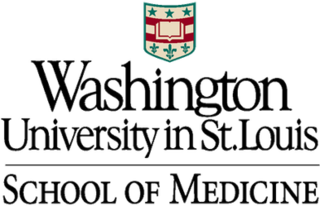
Washington University School of Medicine (WUSM) is the medical school of Washington University in St. Louis, and located in the Central West End neighborhood of St. Louis, Missouri. Founded in 1891, the School of Medicine shares a campus with Barnes-Jewish Hospital, St. Louis Children's Hospital, and the Alvin J. Siteman Cancer Center. It has consistently ranked among the top medical schools in the United States in terms of the number and amount of research grants/funding awarded by the National Institutes of Health, in addition to other measures.

Claire M. Fraser is an American genome scientist and microbiologist who has worked in microbial genomics and genome medicine. Her research has contributed to the understanding of the diversity and evolution of microbial life. Fraser is the director of the Institute for Genome Sciences at the University of Maryland School of Medicine in Baltimore, MD, where she holds the Dean's Endowed Professorship in the School of Medicine. She has joint faculty appointments at the University of Maryland School of Medicine in the Departments of Medicine and Microbiology/Immunology. In 2019, she began serving a one-year term as President-Elect for the American Association for the Advancement of Science (AAAS), which will be followed by a one-year term as AAAS president starting in February 2020 and a one-year term as chair of the Board of Directors in February 2021.

The College of Medicine of Maryland, or also known since 1959 as Davidge Hall, is a historic domed structure in Baltimore, Maryland. It has been in continuous use for medical education since 1813, the oldest such structure in the United States. A wide pediment stands in front of a low, domed drum structure, which housed the anatomical theater. A circular chemistry hall was housed on the lower level under the anatomical theater.
The University of Maryland Marlene and Stewart Greenebaum Comprehensive Cancer Center (UMGCCC) is a National Cancer Institute (NCI)-designated comprehensive cancer center located in Baltimore, Maryland.
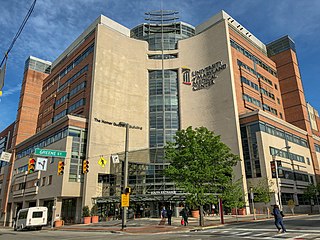
The University of Maryland Medical Center (UMMC) is a teaching hospital with 806 beds based in Baltimore, Maryland, that provides the full range of health care to people throughout Maryland and the Mid-Atlantic region. It gets more than 26,000 inpatient admissions and 284,000 outpatient visits each year. UMMC has approximately 9,050 employees at the UMMC Downtown Campus, as well as 1,300 attending physicians and 950 resident physicians across the Downtown and the Midtown campuses. UMMC provides training for about half of Maryland's physicians and other health care professionals. All members of the medical staff are on the faculty of the University of Maryland School of Medicine.
Clement Adebamowo is a Nigerian medical researcher and academic. Born in Lagos, Nigeria, Adebamowo is currently Director For Global Health Cancer Research, and a professor of Epidemiology & Public Health, at the University of Maryland School of Medicine. He is known for his work in cancer epidemiology, nutrition epidemiology, and research ethics, particularly in low resource and under-served in Africa.
Professor Minesh P. Mehta, MD, FASTRO, is an American radiation oncologist and physician-scientist of Indian origin, Ugandan birth, Zambian Schooling and American Training, who contributed to the field of oncology for more than two and half decades.
An MD–MS program is a dual degree graduate school program awarding both a Doctor of Medicine (MD) and a Master of Surgery (MS) degree. Post-graduate diploma holders and Diplomate of National Board (India) candidates can upgrade to an MD-MS admission 2019-20 degree through opportunities such as post-graduate–up-gradation programs.
Created in 1985, the University of Maryland Graduate School, Baltimore (UMGSB) represents the combined graduate and research programs at the University of Maryland, Baltimore County and the University of Maryland, Baltimore (UMB), the university system's doctoral research campuses in the Baltimore area.
The Institute of Human Virology Nigeria (IHVN) is a non-governmental organization that focuses on HIV/AIDS related problems in Nigeria. It was established as an affiliate to the Institute of Human Virology, University of Maryland School of Medicine, Baltimore in 2004. In 2016, IHVN claimed that it reaches 2.3 million Nigerians with HIV testing services, including about 25,000 who tested positive for the disease.
Owen R. White is a bioinformatician and director of the Institute For Genome Sciences at the University of Maryland School of Medicine, United States. He is known for his work on the bioinformatics tools GLIMMER and MUMmer.
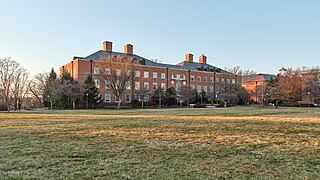
The Johns Hopkins University Department of Biomedical Engineering has both undergraduate and graduate biomedical engineering programs located at the Johns Hopkins University in Baltimore, Maryland.
Linda Chang is an American neurologist. She is a professor of diagnostic radiology and nuclear medicine and the vice-chair for faculty development at University of Maryland School of Medicine.
Margaret M. "Peg" McCarthy is an American neuroscientist and pharmacologist. She is the James & Carolyn Frenkil Endowed Dean's Professor at the University of Maryland School of Medicine, where she is also Professor and Chair of the Department of Pharmacology. She is known for her research on the neuroscience of sex differences and their underlying mechanisms. In 2019, she received the Gill Transformative Investigator Award from the Gill Center for Biomolecular Science at Indiana University.
















